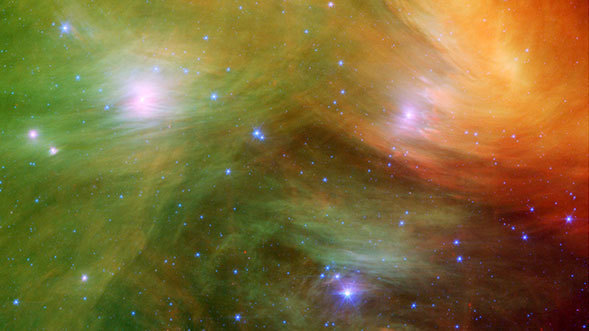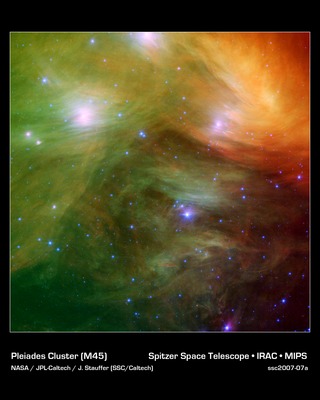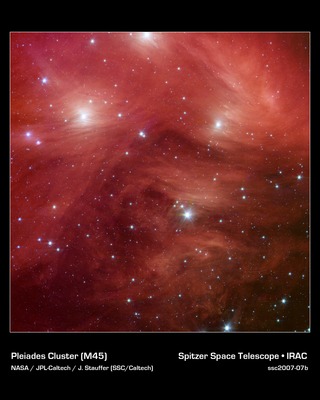
News Release • April 12th, 2007 • ssc2007-07 •
The Seven Sisters, also known as the Pleiades, seem to float on a bed of feathers in a new infrared image from NASA's Spitzer Space Telescope. Clouds of dust sweep around the stars, swaddling them in a cushiony veil.
The view is quite different from what you might see if you look out to the west shortly after dusk. Right now, the famous family of stars is "stepping out" in the evening skies with a very bright and dazzling Venus. During the period from around April 10 to 13, the Pleiades shine like a cluster of diamonds just above Venus. On April 19, the crescent moon will join the party, sliding between Venus and the Pleiades for a special viewing.
Paparazzi and fans in both the northern and southern hemispheres should grab a pair of binoculars to get the best look at the star-studded event. The Venus-Pleiades encounter will also be visible with the naked eye where skies are dark and clear.
The Pleiades, located more than 400 light-years away in the Taurus constellation, are the subject of many legends and writings. Greek mythology holds that the flock of stars was transformed into celestial doves by Zeus to save them from a pursuant Orion. The 19th century poet Alfred Lord Tennyson described them as "glittering like a swarm of fireflies tangled in a silver braid."
The star cluster was born when dinosaurs still roamed the Earth, about 100 million years ago. It is significantly younger than our 5-billion-year-old sun. The brightest members of the cluster, also the highest-mass stars, are known in Greek mythology as two parents, Atlas and Pleione, and their seven daughters, Alcyone, Electra, Maia, Merope, Taygeta, Celaeno, and Asterope. There are thousands of additional lower-mass members, including many stars like our sun. Some scientists believe that our sun grew up in a crowded region like the Pleiades, before migrating to its present, more isolated home.
The new infrared image from Spitzer highlights the "tangled silver braid" mentioned in the poem by Tennyson. This spider-web-like network of filaments, colored yellow, green and red in this view, is made up of dust associated with the cloud through which the cluster is traveling. The densest portion of the cloud appears in yellow and red, and the more diffuse outskirts are shown in green hues. One of the parent stars, Atlas, can be seen at the bottom, while six of the sisters are visible at top. Additional stars in the cluster are sprinkled throughout the picture in blue.
The Spitzer data also reveal never-before-seen brown dwarfs, or "failed stars," and disks of planetary debris (not pictured). John Stauffer of NASA's Spitzer Space Telescope mission says Spitzer's infrared vision allows astronomers to better study the cooler, lower-mass stars in the region, which are much fainter when viewed in optical light. Stauffer, who admits to being biased because the Pleiades is his favorite astronomical object, says the cluster is the perfect laboratory for understanding the evolution of stars.
Whitney Clavin
(818) 354-4673
Jet Propulsion Laboratory,
Pasadena, Calif.
ssc2007-07






